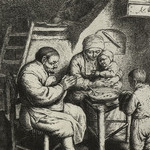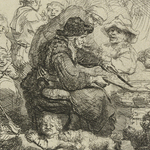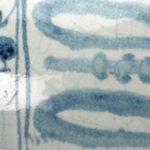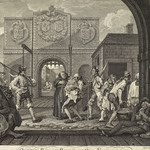Exhibition labels

225: Chapter 10
Chapter 10: The Angel gives St John the book to eat, from The Apocalypse Commonly known as The Apocalypse, this final book in the Bible was widely believed to prophesy the events leading to the end of the world. Here...

226: Peasant family at prayer before eating
Peasant family at prayer before eating In early modern Europe, the ‘blessing of the table’ or ‘benediction’ was said before a meal, while the ‘act of thanks’ or ‘saying grace’ was said at the end. Normally, the father would lead...

227: Title-page to George Hall
Title-page to George Hall, A Fast- Sermon, Preached to the Lords in the High-Court of Parliament Assembled On the Day of Solemn Humiliation for the continuing Pestilence, Octob. 3. Title-page to George Hall, A Fast- Sermon, Preached to the Lords...

229: Bottle or flask
Unidentified Harlow pottery, Essex, England, c.1635–65 Lead-glazed red earthenware with cream slip- trailed decoration, inscribed: ‘IAMES: WANEL: ND/ FEARE GOD THE LORD/AND FAST AND PRAY/ *ABCDEFGHIKLMTHE’ Dr J.W.L. Glaisher Bequest (GL.C.36-1928)

228: Ciborium with The Fall of Manna
Ciborium with The Fall of Manna, Last Supper, and Supper at Emmaus, and cover with vignettes of The Passion of Christ The Passion of Christ The ciborium is used during Holy Communion to hold the bread, normally in the form...
230: One-handled pipkin with pouring lip
Unidentified Harlow pottery, Essex, England, 1650 Lead-glazed red earthenware with cream slip-trailed decoration, inscribed: ‘FAST AND PRAY 1650 W’ Dr J.W.L. Glaisher Bequest (GL.C.35-1928) This bottle and pipkin (a spouted cooking pot with handle to hold over the heat) are...
231: Churchwardens’ Accounts and Orders of Vestry
Churchwardens’ Accounts and Orders of Vestry, St Peter’s Church, Wisbech, 1768 –1805 The Elizabethan Poor Law of 1601 established a national legal framework for dealing with the poor that lasted until 1834. Administered by the Church at...
232: The vision of San Francesco of Paola (1416 –1507)
The vision of San Francesco of Paola (1416 –1507) This three-dimensional portrait emphasises the simplicity of the founder of the Minims, a monastic order based on the rule of St Francis, committed to humility and non-violence. In addition to the...

235: The pancake woman
This tiny etching shows an elderly street- vendor preparing pancakes for eagerly waiting children to consume. Pancakes were a type of food traditionally associated with Carnival, a period of excess and debauchery immediately before Lent, the solemn fasting season when...

236: L’Hyver (Winter), from The Seasons
Here Winter is represented by Mardi Gras, or Shrove Tuesday, the day before Ash Wednesday and the start of Lent. It was the final chance to eat rich food before the culinary restrictions started, and a day of general merriment...

233: The Thin kitchen
This engraving, and its pair called The Fat Kitchen, are based on drawings by Flemish artist Pieter Bruegel the Elder, who often used food as a way to satirise political and social issues. They illustrate the ways that cultural representations...

234: Procession of children with sausages and a pig
Procession of children with sausages and a pig Leaders of the Protestant Reformation told their followers that while they were never to be gluttonous or ungenerous with food, they could choose to eat what they liked, when they liked, visibly...
237: Tacuinum Sanitatis (Strasburg, 1531)
This is a Latin translation of an influential eleventh-century Arabic book, the Taqwim al-Sihhah (The Maintenance of Health) by Baghdadi physician, Ibn Butlan (died c.1038), which combined ancient and Medieval medical traditions in a tabular format. Related to herbals, it...
238: Thomas Tryon, Wisdom's dictates
Thomas Tryon, Wisdom’s dictates, or, Aphorisms & rules, physical, moral, and divine, for preserving the health of the body, and the peace of the mind (London, 1691) A convert to Anabaptism (a branch of radical Protestantism), the seventeenth-century English merchant...
239: John Pechey, The London Dispensatory
John Pechey, The London Dispensatory, Reduced to the Practice of the London Physicians. Wherein are Contain’d The Medicines, both Galenical and Chymical, That are now in Use (London, 1694\n\nJohn Pechey, The London Dispensatory, Reduced to the Practice of the London...
240: John Evelyn, Acetaria, A Discourse of Sallets (London, 1699)
In 1699, John Evelyn, the famous naturalist and gardener, published this homage to salads, the title of which refers to the vinegar used in the dressing. In fact, he described a 9-step recipe for dressing a salad, including specific instructions...

241: One-handled spouted pharmacy jar
Early modern ‘pharmacy jars’ often had painted labels to indicate their contents. These inscriptions frequently used the specialised vocabulary of published medical texts and ‘books of secrets’. This pharmacy jar, formed as a spouted pitcher, is labelled: ‘O[x]ymel composito’. Made...
242: Pharmacy bottle
This colourful spouted pharmacy bottle was designed originally to contain a syrup made with fennel, as indicated by its label, ‘C[onfectio]. DE. FENOCHI’, meaning ‘decoction of fennel’, obtained by heating or boiling the plant to extract its essence. Fennel was...

243: One-handled spouted pharmacy
One-handled spouted pharmacy jar for the Camaldolensian convent, Arezzo This pharmacy jar’s inscription, ‘Syo: D RIBES’ (‘syrup of currants’), tells us that it was designed originally to hold blackcurrant or redcurrant syrup, believed to help with coughs or lung ailments...
244: The Reverend Licentiate Sédillo at Dinner
The Reverend Licentiate Sédillo at Dinner or or The Reverend Licentiate Sédillo at Dinner or The Canon’s Gluttony This is a scene from the popular French comic novel, L’Histoire de Gil Blas de Santillane by Alain-René Lesage, which was published...
245: Cover depicting The Holy Family
Cover depicting The Holy Family from a (lost) accouchement set\nfrom a (lost) accouchement set Recovery from childbirth – the most dangerous experience in most women’s lives – required nourishing food, like sweetmeats or broths. In Italy, these were traditionally served...

246: Toddler with fruit in a mobile highchair
This curious figurine depicts a toddler in an elaborate wheeled chair – a combination of a baby-stroller and highchair – feeding herself some fruit. The early modern period saw the development of children’s furniture, like highchairs, which encouraged the child...

247: Two-handled spouted porringer and cover
Porringers are small bowls for eating porridge or gruel, often used to feed the sick or elderly. They usually have one or two handles and were made in a range of materials. This Dutch Delftware example is unusual because it...
248: Tripartite food warmer (veilleuse)
By the eighteenth century, infants and invalids were often fed easily digestible foods kept warm in a veilleuse (veiller means ‘to watch over’ or ‘stay awake’ in French), which could be brought to the bedside. The food was placed inside...

249: One-handled spouted feeding cup
The sick were sometimes able to feed themselves, with specially designed feeding cups such as this delicate German example, whose small scale and limited capacity show that it was intended for individual use. These were easier to manage than posset...

250: The Roast Beef of Old England &c.
The Roast Beef of Old England &c. or The Gate of Calais This print demonstrates the power of the stereotype of the meat-eating Briton. Engraved from Hogarth’s painting (now in Tate Britain), it commemorates his visit to Calais in March...

251: The Turf–Macaroni, The Duke of Grafton
The Turf–Macaroni, The Duke of Grafton, No. 12 from Twenty-Four Caricatures by Several Ladies, Gentlemen, Artists, etc. Food has long been central to the construction of national stereotypes and identities. In the eighteenth century, many wealthy young men completed their...

252: French Liberty
British Slavery French Liberty; British Slavery This well-known satirical print of 1792 compares an emaciated French revolutionary devouring onions and garlic to the archetypal Briton (represented by an obese John Bull, who personified the country) tucking into an enormous joint...

253: The British Butcher
Supplying John Bull with a Substitute for Bread,\nThe British Butcher, Supplying John Bull with a Substitute for Bread, vide Message to Lord Mayor Within the context of the French Wars (1792 – 1802), the high price of wheat became the...

254: Substitutes for Bread
Substitutes for Bread; -or- Right Honorables, Saving the Loaves & Dividing the Fishes Gillray portrays five key politicians greedily shovelling fish and turtle soup made from coins into their mouths, surrounded by bottles of burgundy, port, and champagne, as three...





